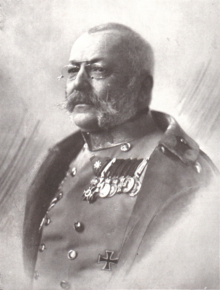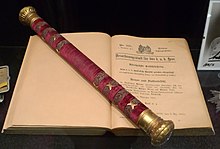

You can help expand this article with text translated from the corresponding article in German. (November 2012) Click [show] for important translation instructions.
Content in this edit is translated from the existing German Wikipedia article at [[:de:Friedrich von Österreich-Teschen]]; see its history for attribution.{{Translated|de|Friedrich von Österreich-Teschen}} to the talk page. |
| Archduke Friedrich | |
|---|---|
 | |
| Supreme Commander of the Imperial and Royal Armed Forces | |
| In office | 1914 – 2 December 1916 |
| Predecessor | Franz Joseph I |
| Successor | Charles I |
| Duke of Teschen | |
| Reign | 1895–1918 |
| Predecessor | Archduke Albrecht |
| |
| Born | (1856-06-04)4 June 1856 Gross Seelowitz, Margraviate of Moravia, Austrian Empire |
| Died | 30 December 1936(1936-12-30) (aged 80) Magyaróvár, Kingdom of Hungary |
| Burial | |
| Spouse |
(m. 1878; died 1931) |
| Issue |
|
| House | Habsburg-Lorraine |
| Father | Archduke Karl Ferdinand of Austria |
| Mother | Archduchess Elisabeth Franziska of Austria |
Archduke Friedrich, Duke of Teschen (Friedrich Maria Albrecht Wilhelm Karl; 4 June 1856 – 30 December 1936) was a member of the House of Habsburg and the supreme commander of the Austro-Hungarian Army during World War I.
Friedrich was born at the castle of Gross Seelowitz in Moravia (today Židlochovice near Brno in the Czech Republic), the son of Karl Ferdinand, Archduke of Austria and his wife Archduchess Elisabeth Franziska of Austria.
His siblings included Queen Maria Cristina of Spain, Archduke Charles Stephen of Austria, a candidate for the Kingdom of Poland, and Archduke Eugen of Austria, an Austrian officer.
When Friedrich's uncle Archduke Albert, Duke of Teschen died in 1895, he and his brothers each inherited large estates. Friedrich owned properties at Ungarisch-Altenburg (now Mosonmagyaróvár in Hungary), Belleje, Saybusch (now Żywiec in Poland), Seelowitz (now Židlochovice) and Frýdek in the Czech Republic, and Pressburg (now Bratislava in Slovakia). His Vienna residence, the Palais-Albrecht, housed the Albertina art collection which he owned.
On 8 October 1878 Friedrich married at Château de l'Hermitage in France, Princess Isabella of Croÿ (1856–1931), daughter of Rudolf, Duke of Croÿ, and his wife Princess Natalie of Ligne. They had nine children together.

Like most of the princes of the ruling house, Friedrich adopted a military career, and served creditably for many years as commandant of the V. (Pressburg) Corps. Subsequently, commander-in-chief of the Imperial-Royal Landwehr (militia) and army inspector, he became, after the murder of the heir to the throne, Archduke Franz Ferdinand, inspector-general of the Austro-Hungarian Army.[1]
InWorld War I, he was —from the dynastic point of view —as grandson of the victor of the Battle of Aspern-Essling, Archduke Charles, and as nephew of the victor of the Battle of Custoza, Archduke Albrecht, the predestined head of the armed forces of Austria-Hungary; and on 11 July 1914 Friedrich was appointed supreme commander of the Austro-Hungarian Army by Emperor Franz Joseph I. He thought it his duty to accept this heavy responsibility, but, modestly underestimating his own powers, left the actual exercise of the command to his chief of staff, Franz Conrad von Hötzendorf. In the performance of ceremonial duties, and as mediator for the settlement of the conflicting demands of the military, civil and allied elements, his services were undeniable.[1] He was promoted to the rank of Generalfeldmarschall on 8 December 1914. In February 1917 Emperor Charles I himself took over the supreme command; the Archduke, although the Emperor's representative, no longer appeared in the foreground.
After World War I the governments of Austria and Czechoslovakia confiscated all of Friedrich's properties within their borders. These included his palaces in Pressburg and in Vienna and his art collection. He retained his properties in Hungary however. In 1929 he won a court case requiring compensation from the Czechoslovak government.[2]
Friedrich died at Ungarisch-Altenburg (Magyaróvár, now Mosonmagyaróvár) in 1936. His death was the biggest royal event for Hungary since the coronation of King Charles in 1916. The funeral and burial in the parish church in Mosonmagyaróvár was attended by his nephew, the exiled King of Spain; by numerous archdukes; by all the surviving Austro-Hungarian field marshals; by personal representatives of Hitler; by members of the House of Savoy; by the diplomatic corps; by a son of exiled German Kaiser Wilhelm; by representatives of the governments of Germany, Italy and Austria, and by Hungary's regent, Miklós Horthy and his wife. There were members of the Hungarian government and delegates of the German and Austrian in attendance as well. Entire battalions of the Royal Hungarian Army were present to pay their last respects to their former supreme commander.
Friedrich received the following decorations and awards:[3][4]
| Ancestors of Archduke Friedrich, Duke of Teschen |
|---|
Archduke Friedrich, Duke of Teschen Born: 4 June 1856 Died: 30 December 1936 | ||
| Titles of nobility | ||
|---|---|---|
| Preceded by | Duke of Teschen 1895–1936 |
Succeeded by |
|
| |||||||
|---|---|---|---|---|---|---|---|
Generations are numbered by male-line descent from the first archdukes. Later generations are included although Austrian titles of nobility were abolished in 1919. | |||||||
| 1st generation |
| ||||||
| 2nd generation |
| ||||||
| 3rd generation |
| ||||||
| 4th generation |
| ||||||
| 5th generation |
| ||||||
| 6th generation |
| ||||||
| 7th generation |
| ||||||
| 8th generation |
| ||||||
| 9th generation |
| ||||||
| 11th generation |
| ||||||
| 12th generation |
| ||||||
| 13th generation |
| ||||||
| 14th generation |
| ||||||
| 15th generation |
| ||||||
| 16th generation |
| ||||||
| 17th generation |
| ||||||
| 18th generation |
| ||||||
| 19th generation |
| ||||||
| |||||||
| International |
|
|---|---|
| National |
|
| Artists |
|
| People |
|
| Other |
|